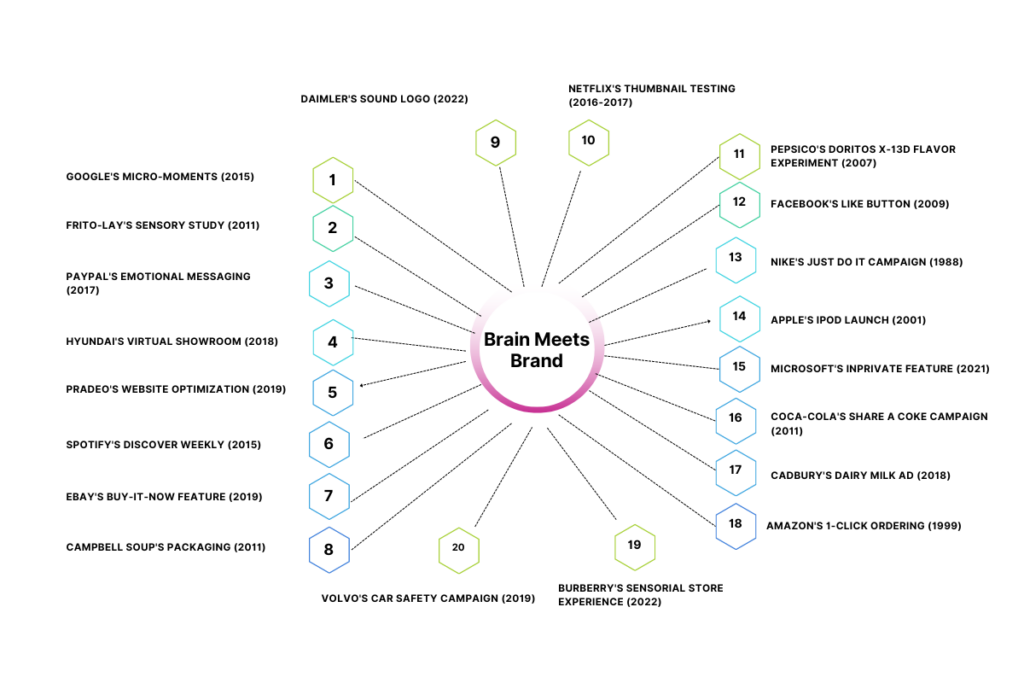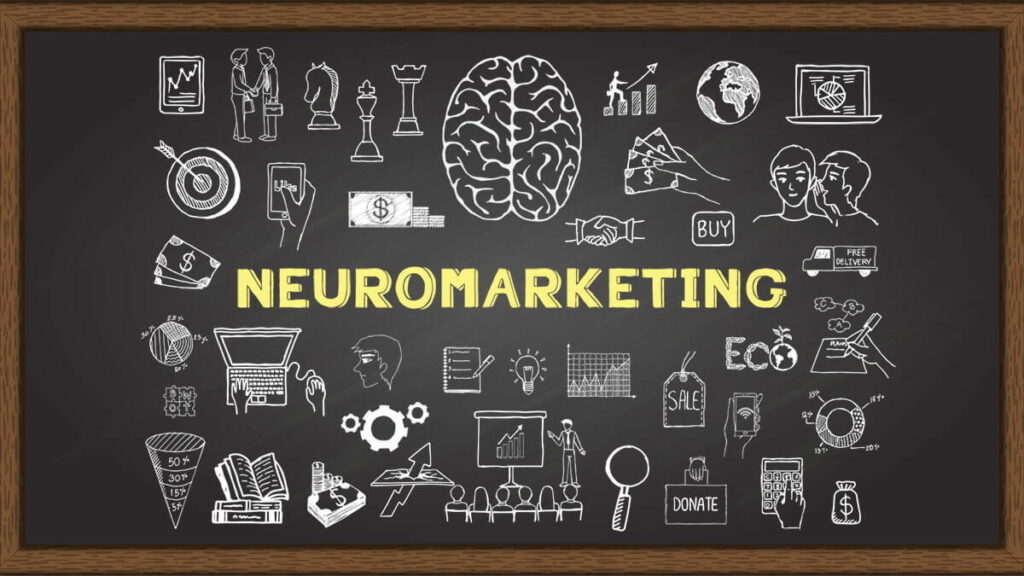Understanding Neuromarketing
Neuromarketing is when scientists and people who sell things work together to figure out why people like certain things when they shop. They use special science tricks to study how our brains react to ads and products.
This helps companies make better ads and things to sell, so more people want to buy them. They use tools like EEG and fMRI to see what our brains like, and then they use that information to make better ads and products that we will like. Overall, neuromarketing helps make ads and products better so that we want to buy them more.
The Birth of Neuromarketing: A Brief History
Neuromarketing is a new way of studying why people buy things. It started in the early 2000s and uses special machines to look at how our brains react to advertising. This helps companies understand how to make ads that make people want to buy their products.

The Early Days:
The concept of neuromarketing can be traced back to the early 1990s, when Gerald Zaltman, a Harvard professor, developed the “Zaltman Metaphor Elicitation Technique” (ZMET). This technique was one of the first to use neuroscientific principles to understand consumer thoughts and feelings. Zaltman’s work laid the groundwork for the application of neuroscience in marketing, although the term “neuromarketing” had not yet been coined.
The Birth of Neuromarketing:
The term “neuromarketing” itself first appeared in the early 2000s. In 2002, Ale Smidts, a professor of marketing research at the Rotterdam School of Management, is credited with coining the term. Around the same time, BrightHouse, a consultancy firm based in Atlanta, launched one of the first neuromarketing research initiatives. They established a “Neurostrategies” division, partnering with Emory University’s scientists to apply neuroimaging techniques to marketing studies. This collaboration marked a significant milestone in the formalization of neuromarketing as a field.
Technological Advancements:
The growth of neuromarketing has been closely tied to advancements in neuroimaging technologies. Techniques such as functional Magnetic Resonance Imaging (fMRI) and Electroencephalography (EEG) have become invaluable tools for neuromarketers. These technologies allow researchers to observe and measure brain activity in response to marketing stimuli, providing insights into the emotional and cognitive processes that underlie consumer behavior.
Key Milestones and Studies:
In 2004, a famous study was done to see how people’s brains react to Pepsi and Coca-Cola. The study found that what people think about the brands can affect which one they like better. This shows how important advertising and branding can be in making people choose one product over another.
Neuromarketing helps companies understand what people like and how they make decisions by looking at their brains. Some people worry that this is not fair, but others think it can help businesses. As technology gets better, neuromarketing will become more important in how companies sell things. It’s important for companies to use this information in a good and fair way to keep their customers happy.
Defining Neuromarketing: The Science of Consumer Behavior
Neuromarketing is like being a detective for why people like to buy things. It uses science to figure out why certain things, like the colors of a toy or the music in a commercial, make people feel happy or want to buy something. This helps companies make ads that people really like, making them want to buy more stuff.
Imagine if you could know what makes your friend happy when they see a toy, and then use that secret to make the best toy ad ever. That’s what businesses do with neuromarketing. They learn what people love without them even saying it, and then make their ads with those secrets so more people buy their stuff.
In a world where lots of companies are trying to sell things, knowing these secrets helps some companies be more liked by people, making them want to buy more from these companies.
The Science Behind Neuromarketing
Neuromarketing stands at the fascinating intersection of marketing and neuroscience, offering unprecedented insights into consumer behavior. By understanding the science behind neuromarketing, businesses can unlock powerful strategies to connect with their audience on a deeper level.
How Neuromarketing Works: An Overview of the Process

At the heart of neuromarketing lies the fascinating blend of neuroscience and marketing principles, aimed at unraveling how consumers respond to various marketing elements. By leveraging cutting-edge tools like eye-tracking, EEG (Electroencephalography), and fMRI (Functional Magnetic Resonance Imaging), researchers can dive deep into the brain’s reactions to different marketing stimuli, observing the intricate dance of neurons in real time.
This journey into the brain’s response offers invaluable insights, shedding light on the emotional and cognitive underpinnings that sway consumers’ buying behaviors. For example, through the lens of eye-tracking technology, we can pinpoint exactly what draws a viewer’s gaze within an ad. Meanwhile, EEG and fMRI technologies allow us to peek into the realms of emotional connection and how well the content sticks in the memory, providing clues on how marketing can effectively resonate with its audience.
Isn’t it amazing how technology gives us a front-row seat to the inner workings of our minds, especially in the context of marketing? It’s like having a backstage pass to the show that is our decision-making process, revealing the secret cues that lead us to say “yes” to certain products and “no” to others.
The Brain on Brands: Neuroscience Meets Marketing
Neuromarketing is like when science helps people who sell things understand how our brains work. It shows that when we decide to buy something, it’s often because we feel a certain way about it, not just because we think it’s a good idea. So, if a company can make us feel happy, excited, or even just comfortable with their product, we’re more likely to want to buy it.

For example, when you hear a story in an advertisement that makes you feel something, like happiness or excitement, your brain remembers it better. Or, when you see a logo or a color that makes you feel good, you might like that product more without even knowing why.
Neuromarketing means that companies try really hard to make their stuff seem really appealing to our feelings. They use what science tells them about our brains to try to make ads or products that we’ll really like, not just because they’re good, but because they make us feel good.
This is important for companies because the world is full of different things to buy, and they want you to choose their product. By using neuromarketing, they can make sure their stuff stands out by connecting with us on an emotional level, which can make us want to buy from them more and more.
In today’s competitive landscape, staying informed about the latest developments in neuromarketing and continuously applying these insights can help businesses of all sizes to connect with their audience more effectively and achieve sustainable growth.
Key Techniques in Neuromarketing
Eye Tracking: Gaze Into Your Customer’s Desires
The Magic of Seeing What Consumers See
Eye tracking technology helps businesses see where people are looking when they are shopping. This helps them understand what people like and want, so they can make their stores and ads better for their customers. It can also be used to make websites and software easier to use by seeing where people are looking and how long they are looking there. This can help make things better for people using the websites and software. As technology gets better, eye tracking can help businesses understand even more about what people like and improve their products and services.

EEG (Electroencephalogram): Listening to the Brain’s Whispers
Unpacking Thoughts: How EEG Decodes Consumer Preferences
It’s really important for businesses to know what people are thinking and feeling when they buy things. They can use special technology to see what’s going on inside people’s brains and figure out what they like and don’t like. This helps them make better ads and products that people will really like. It also helps them stay ahead of what people want and make even better things in the future. This can help businesses do better than their competition and make their customers really happy.
Understanding consumer behavior is crucial for businesses to thrive in today’s competitive market. By utilizing advanced technology to gain insights into the preferences and emotions of their target audience, companies can tailor their marketing strategies and product development to better meet consumer needs. This not only allows businesses to stay ahead of the curve but also fosters customer satisfaction and loyalty. For example, by analyzing brain activity, companies can identify which features of a product resonate most with consumers, leading to more effective advertising and improved customer experiences. Ultimately, this proactive approach enables businesses to outperform their competitors and continuously innovate to exceed customer expectations.
As a result, businesses can make data-driven decisions that are more likely to resonate with their target audience, leading to increased sales and market share. By understanding consumer behavior, companies can also anticipate changing preferences and trends, allowing them to adapt their offerings and stay relevant in the market. This proactive approach not only benefits businesses but also enhances the overall customer experience, ultimately contributing to long-term success.
fMRI (Functional Magnetic Resonance Imaging): The Deep Dive into Consumer Minds
Beyond the Surface: Understanding Deep-Rooted Consumer Attitudes
To truly understand consumer behavior, businesses need to dive deep into their customers’ minds. Functional Magnetic Resonance Imaging (fMRI) provides a window into the neural processes that shape consumer attitudes and decision-making. By uncovering the subconscious motivations behind consumer choices, marketers can create more effective strategies that resonate on a deeper level.
Businesses can use a special kind of machine to see how people’s brains work when they see or hear about products. This helps them figure out what makes people want to buy things. They can use this information to make their ads, stores, and products more appealing to customers. It can also help them test if their ads are working. This helps businesses do a better job of getting people to buy their stuff.
Why Neuromarketing Matters for Your Business
To do well in business, it’s really important to know why people buy things. Neuromarketing helps us understand the hidden reasons that affect people’s choices. This can help businesses make better plans for selling things and make their customers happier. Neuromarketing uses brain imaging and other neuroscience techniques to study how consumers respond to different marketing stimuli. By understanding the subconscious factors that influence consumer behavior, businesses can tailor their marketing strategies to better connect with their target audience. This can lead to more effective advertising, product development, and overall customer satisfaction. In today’s competitive market, having a deep understanding of consumer behavior can give businesses a significant edge.
Unlocking the Secrets of Consumer Choices
Neuromarketing is a way for businesses to understand why people buy things. They study how our brains work and how we feel to figure out what makes us choose certain products. This helps them make advertisements that are just right for the people they want to buy their stuff. Neuromarketing techniques include using brain imaging to see which areas of the brain are active when people are exposed to marketing stimuli.
By understanding the neurological processes behind consumer behavior, businesses can tailor their marketing strategies to better appeal to their target audience. This can result in more effective advertising campaigns and ultimately lead to increased sales and brand loyalty. Additionally, neuromarketing can also help businesses understand the subconscious factors that influence consumer decision-making, allowing them to create more persuasive messaging and branding.
Enhancing Customer Experience Through Neuroscience
Neuromarketing surpasses conventional market research techniques by applying principles from neuroscience. This approach enables businesses to optimize the customer experience by understanding how the brain processes information. From website design to product packaging, every interaction point can be improved to create a more compelling and persuasive experience for customers. By leveraging the insights gained from neuromarketing, companies can tailor their marketing strategies to better resonate with their target audience.
Building a deeper understanding of consumer behavior through neuromarketing can also lead to more effective advertising campaigns. By tapping into the subconscious motivations and responses of the target audience, companies can create ads that resonate on a deeper level and drive stronger emotional connections. This can result in higher brand loyalty and increased customer retention. Additionally, neuromarketing can also inform pricing strategies by uncovering how the brain perceives value, leading to more strategic pricing decisions. Overall, the insights gained from neuromarketing can revolutionize the way businesses approach marketing and ultimately lead to more successful and impactful customer interactions.
The Competitive Edge: Standing Out in a Crowded Market
In a busy place where people sell things, it’s important for businesses to find ways to be noticed. Neuromarketing helps companies to be different from others and get the attention of the people they want to sell to. By understanding how people think and feel, businesses can make special and powerful ads that really connect with people.
Neuromarketing strategies can be a game-changer for businesses aiming to craft more personal and impactful marketing campaigns. By delving into the subconscious desires of their target audience, companies are able to customize their communications and brand image in ways that deeply connect with consumers. Imagine the power of choosing just the right colors to stir specific feelings, or shaping packaging that hits the right sensory notes. These tactics can profoundly influence how consumers perceive products and make buying decisions, giving businesses a leg up in the fiercely competitive market arena. This kind of savvy and tailored approach can not only boost brand loyalty but also drive sales sky-high.
To wrap it up, the significance of neuromarketing in today’s commercial world cannot be overstated. By uncovering the hidden drivers behind consumer behavior and refining the customer journey with neuroscience insights, companies can carve out a distinctive advantage, paving the way for enduring success across industries.
Crafting a Neuromarketing Strategy
Crafting a solid neuromarketing strategy is crucial for businesses looking to understand and influence consumer behavior. By integrating neuroscience principles into your marketing efforts, you can achieve better results and improve the effectiveness of your campaigns.
Neuromarketing allows businesses to tap into the subconscious thoughts and emotions of consumers, providing valuable insights into their decision-making processes. By utilizing techniques such as eye tracking, facial coding, and brain imaging, businesses can gain a deeper understanding of consumer preferences and behavior. This can lead to more targeted and impactful marketing strategies that resonate with the audience on a subconscious level, ultimately driving better engagement and conversion rates.

Setting Goals: What Do You Want to Achieve with Neuromarketing?
Before diving into neuromarketing, it’s essential to define your goals. Ask yourself what you want to achieve through this approach. Do you want to understand consumer preferences better? Do you want to optimize your messaging to create a stronger emotional connection with your audience? Clearly defining your objectives allows you to tailor your neuromarketing strategy to meet those specific goals.
Choosing the Right Neuromarketing Techniques for Your Business
Neuromarketing is a way to understand why people buy things. There are different methods like looking at where people’s eyes go, measuring brain waves, and using special scans. It’s important to pick the right method for what you want to learn and who you want to learn about. You should do a lot of research and talk to people who know a lot about this to pick the best method for your business.
Integrating Neuromarketing into Your Marketing Plan
For neuromarketing to be successful, it should be seamlessly integrated into your overall marketing plan. Identify touchpoints where you can apply neuromarketing insights, such as website design, advertising campaigns, and product packaging. By incorporating neuromarketing principles into your existing marketing efforts, you can amplify their impact and drive better results.
In summary, making a neuromarketing plan means deciding what you want to achieve, picking the right ways to do it, and fitting it into your overall marketing plan. By doing this, businesses can better understand how people think and make ads that really connect with the people they want to reach.
Measuring the Impact of Neuromarketing
When using neuromarketing, it’s important to measure how well it works. This means keeping track of important numbers and figuring out if it is worth the money. This helps businesses make smart choices and make their marketing better. One way to measure the effectiveness of neuromarketing is to track the changes in consumer behavior and purchasing decisions after implementing neuromarketing strategies. This can be done through surveys, focus groups, and analyzing sales data. By comparing these metrics before and after using neuromarketing, businesses can determine the impact it has on their bottom line.
Additionally, conducting A/B testing can help identify which neuromarketing techniques are most effective in influencing consumer behavior. This data-driven approach allows businesses to make informed decisions about their marketing strategies and allocate resources more effectively.
Key Metrics for Neuromarketing Success
To assess the impact of your neuromarketing initiatives, it is crucial to monitor key metrics. Here are some important metrics to consider:
- Conversion Rate: We want to see how many people who visit a website or store actually do what we want them to do, like buy something or sign up for a newsletter. This helps us know if our marketing ideas are working well to make people do what we want.
- Engagement Metrics: We need to keep track of how long people stay on our website, how many pages they look at, and if they leave right away. This helps us know if they are interested in what we are showing them. If they stay and look at a lot of pages, it means they like it.
- Brand Perception: We can use surveys, interviews, or looking at how people feel on social media to see if our marketing has made people think better of our brand. If more people like our brand because of our marketing, then we know our marketing is working well.
The ROI of Neuromarketing: Evaluating Your Investment
Evaluating the return on investment is crucial to ensure the effectiveness and efficiency of your neuromarketing efforts. Here’s how to calculate the ROI:
- Determine the total cost of your neuromarketing initiative, including research, technology, and implementation costs.
- Measure the financial impact generated as a result of your neuromarketing campaign. This could include an increase in sales, customer acquisition, or customer lifetime value.
- Calculate the ROI using the formula: (Net Profit – Investment Cost) / Investment Cost * 100.
You can figure out if your marketing plan is working by looking at the ROI. This helps you decide if it’s good to keep using this plan and if you should put more money into it.
Implementing Neuromarketing in Small to Medium Enterprises (SMEs)
Small to Medium Enterprises (SMEs) stand to gain significantly from integrating neuromarketing strategies into their marketing efforts. Neuromarketing, the application of neuroscience to marketing, provides insights into consumer behavior that traditional methods might overlook. For SMEs, leveraging neuromarketing can lead to more effective advertising, product development, and customer engagement, ultimately enhancing ROI.

Neuromarketing on a Budget: Tips for SMEs
Prioritize Your Goals
First, figure out what you want to achieve with your advertising. Do you want more people to know about your brand, sell more things, or make customers like your brand more? Once you know your goals, you can pick the best ways to use neuromarketing to help you reach those goals without spending too much money.
Leverage Free and Low-Cost Tools
Neuromarketing tools and software can help small businesses understand what customers like. Some of these tools are free or not too expensive. For example, there are special programs that can track where people look, and simple devices that can measure brain activity. These tools can give businesses helpful information about what customers want, without costing a lot of money.
Focus on Emotional Engagement
Neuromarketing is about making people feel a strong connection to a product or advertisement. Small businesses can make ads that make people feel strong emotions by understanding what makes them feel that way. You don’t need a lot of money to do this, just a good understanding of what people like and need.
Neuromarketing can be a powerful tool for small businesses looking to create impactful advertising on a budget. By tapping into the emotional triggers that resonate with their target audience, businesses can craft compelling ads that leave a lasting impression. For example, understanding the psychological factors that drive consumer behavior can help businesses create ads that evoke feelings of trust, excitement, or nostalgia. By leveraging these insights, small businesses can effectively compete with larger companies in the advertising space, ultimately driving stronger connections with their audience and boosting sales.
Utilize Online Surveys and Feedback
We can use online surveys and feedback tools to learn about what people like and how they act when they buy things. By asking the right questions, we can figure out what people really like and want. This information can help us tailor our products and services to better meet the needs and preferences of our customers.
Additionally, analyzing customer feedback can provide valuable insights into areas for improvement and potential new opportunities. By regularly gathering and analyzing customer feedback, we can ensure that our business remains competitive and responsive to the changing needs of our target market.
Case Studies: SMEs Winning with Neuromarketing
The Boutique Retailer Boost
A boutique retailer used eye-tracking technology to redesign their website layout, resulting in a 30% increase in online sales. By understanding where consumers focused their attention, the retailer could highlight key products and offers effectively.
The Food Industry Success
An SME in the food industry utilized EEG to test consumer reactions to different packaging designs. The data led to a redesign of their product packaging, which saw a 20% increase in shelf pick-up rate and a significant boost in sales.
The Local Service Provider Leap
A local service provider implemented emotional engagement strategies in their marketing campaigns, based on neuromarketing principles. By focusing on storytelling that resonated with their target audience, they experienced a 40% increase in customer inquiries and a substantial improvement in customer retention rates.
Neuromarketing can help small businesses do better at selling their products without using too many resources. They can use smart techniques and tools that fit their needs and budget. By using these techniques, small businesses can make their marketing better, get more customers, sell more, and grow their business.
Overcoming Challenges in Neuromarketing
Implementing neuromarketing strategies in Small to Medium Enterprises (SMEs) can be a game-changer, offering deep insights into consumer behavior and preferences. However, it comes with its set of challenges. By understanding these hurdles and adopting strategic approaches, SMEs can effectively leverage neuromarketing to drive business growth.
Common Pitfalls and How to Avoid Them
Focusing Solely on Technology
Pitfall: Relying exclusively on neuromarketing technology without integrating traditional marketing insights can lead to a narrow understanding of consumer behavior.
Solution: Blend neuromarketing data with conventional market research to gain a holistic view of your audience. This approach ensures a balanced marketing strategy that leverages both emotional and rational consumer responses.
Overlooking Privacy Concerns
Pitfall: Ignoring the ethical implications and privacy concerns related to neuromarketing can tarnish a brand’s reputation and erode trust.
Solution: Be transparent about your neuromarketing practices. Ensure that consumer data is collected ethically, with consent, and used responsibly. This transparency builds trust and reinforces your brand’s integrity.
Ignoring the Context
Pitfall: Neuromarketing data can be misleading if the context of the consumer’s environment and psychological state is not considered.
Solution: Always analyze neuromarketing data within the context of the consumer’s journey and external influences. This approach ensures that strategies are relevant and effectively targeted.
Navigating the Complexity of Consumer Brains
The human brain is incredibly complex, and understanding its response to marketing stimuli requires a nuanced approach. Here are strategies to navigate these complexities effectively:
Embrace a Multidisciplinary Approach
Integrate insights from psychology, neuroscience, and marketing to develop strategies that resonate on multiple levels. This multidisciplinary approach allows for a deeper understanding of consumer behavior.
Experiment and Iterate
Consumer behavior is not static, so your neuromarketing strategies shouldn’t be either. Conduct controlled experiments to test different approaches, and use the results to refine your strategies. This iterative process ensures your neuromarketing efforts remain effective and relevant.
Focus on Emotional Engagement
Emotions play a crucial role in decision-making. Develop marketing strategies that connect emotionally with your audience. Emotional engagement can significantly enhance brand loyalty and influence purchasing decisions.
Remember, the key is to use neuromarketing as a tool to complement and enhance traditional marketing efforts, not replace them. With the right approach, neuromarketing can provide valuable insights that lead to more engaging, effective, and successful marketing campaigns.
The Future of Neuromarketing

Neuromarketing is a way of studying how people make choices about what to buy. In the future, it will get even better at understanding why people like certain things and how they decide what to buy.
Emerging Trends in Neuromarketing Technology
In the rapidly evolving field of neuromarketing, new technologies and methodologies are continually emerging, offering deeper insights and more effective marketing strategies.
Integration of AI and Machine Learning
Trend: The integration of artificial intelligence (AI) and machine learning with neuromarketing tools is revolutionizing how we analyze and interpret data. These technologies can process vast amounts of data at unprecedented speeds, identifying patterns and predicting consumer behavior with remarkable accuracy.
Impact: This allows for highly personalized marketing strategies that can adapt in real-time, enhancing customer engagement and increasing conversion rates.
Virtual Reality (VR) and Augmented Reality (AR) in Neuromarketing
Trend: VR and AR technologies are becoming increasingly prevalent in neuromarketing research, providing immersive experiences that can elicit genuine consumer reactions and emotions.
Impact: By simulating real-life scenarios, businesses can gain authentic insights into consumer behavior and preferences, leading to more effective product designs and marketing campaigns.
Wearable Neurotechnology
Trend: The use of wearable neurotechnology for neuromarketing research is on the rise. Devices such as EEG headbands and biometric sensors can measure brain activity and physiological responses in real-world settings, offering a more accurate picture of consumer responses.
Impact: This trend enables marketers to understand how consumers react in natural environments, leading to more authentic and effective marketing strategies.
The Evolution of Consumer Science: What’s Next?
As neuromarketing continues to grow, its influence on consumer science becomes increasingly significant, shaping the future of how businesses understand and interact with their customers. Neuromarketing has the potential to provide businesses with valuable insights into consumer behavior, allowing them to create more targeted and effective marketing strategies. By understanding the subconscious processes that drive consumer decision-making, businesses can tailor their messaging and product offerings to better meet the needs and desires of their target audience.
As neuromarketing techniques continue to advance, businesses will have even greater opportunities to connect with consumers on a deeper level, ultimately leading to more meaningful and profitable relationships. As a result, the integration of neuromarketing into business practices is likely to become increasingly common in the coming years, as companies seek to gain a competitive edge in the marketplace.
From Insight to Action
The next phase in the evolution of consumer science involves not just gathering insights but also translating these insights into actionable strategies that drive real business outcomes. This requires a seamless integration of neuromarketing data into marketing and product development processes.
Ethical Considerations and Consumer Privacy
As neuromarketing techniques become more advanced, ethical considerations and consumer privacy issues will take center stage. Ensuring that neuromarketing practices are transparent and respect consumer privacy will be crucial for maintaining trust and integrity in the field.
Global Implications
Neuromarketing is set to have a global impact, with businesses around the world leveraging these insights to cater to diverse markets. Understanding cultural differences in consumer behavior will be essential for the global application of neuromarketing strategies.
The future of neuromarketing is ripe with potential, offering exciting opportunities for businesses to connect with their customers on a deeper level. By staying abreast of emerging trends and evolving consumer science, marketers can harness the power of neuromarketing to create more effective, engaging, and successful marketing campaigns.
Getting Started with Neuromarketing
It’s about finding the best ways to advertise and sell things by understanding how people’s brains work. You’ll learn how to start and find the right people to help you.
First Steps: How to Begin Your Neuromarketing Journey
It’s important to know what you want to achieve with neuromarketing and do research to understand how it can help your marketing. Find ways that neuromarketing can make customers more interested in your brand and increase how many people buy your products.
Make sure your website and the things you put on it are easy for people to use, because this is really important for marketing to people’s brains. It’s also important to make things that are interesting and make people feel something. And, it’s a good idea to keep learning about new ways to do this so you can be better than other people who are trying to sell things.
Finding the Right Partners: Choosing a Neuromarketing Agency
Picking the right neuromarketing agency is really important for your marketing plans to work well. You should choose one that has a lot of experience and has helped other companies with their marketing using neuroscience. Make sure to check their past work and what their clients have said about them to see if they are good at getting real results with their neuromarketing strategies.
Consider the agency’s approach to data analysis, consumer behavior research, and application of neuroscientific findings in marketing campaigns. Collaborating with a reputable neuromarketing agency can unlock opportunities for profound insights into consumer motivations and decision-making processes.

At Limitless Neurolab, our agency specializes in providing Neuromarketing solutions tailored to elevate your business. We are excited to offer a complimentary consultation to understand your needs better. Our track record speaks volumes, with numerous businesses benefiting from our expertise. Additionally, our neurobranding services are designed to enhance your brand’s appeal further. Let us collaborate to distinguish your business in the marketplace.
Starting a neuromarketing journey means having a plan and working with the right people. When you start and choose the right company to help you, you can use neuromarketing to make your advertising and marketing even better.
Conclusion
In summary, neuromarketing helps businesses understand how people think and feel so they can make better advertisements and sell more products. It uses science to make ads that people really like. Neuromarketing also allows businesses to understand consumer behavior on a deeper level by analyzing brain activity and emotional responses to different stimuli. By tapping into the subconscious mind, businesses can create more effective marketing strategies that resonate with their target audience.
Furthermore, neuromarketing can provide valuable insights into consumer decision-making processes, helping businesses tailor their products and messaging to better meet the needs and desires of their customers. Overall, the application of neuromarketing techniques can give businesses a competitive edge in understanding and influencing consumer behavior.
The Unmatched Value of Neuromarketing for Businesses
Neuromarketing is like a secret way for stores to learn what people like and why they buy things without asking them directly. It’s like reading minds a little bit. They watch how people react to stuff without them even realizing, so they can figure out the best ways to show and sell things to make people want to buy them. It’s like making a puzzle that fits perfectly with what people already like, so they feel happy and want to buy things.
Neuromarketing techniques, such as analyzing brain activity and measuring physiological responses, enable businesses to uncover hidden insights that traditional market research may miss. By tapping into the emotional and cognitive aspects of consumer decision-making, businesses can craft strategies that resonate with their target audience on a deep, subconscious level.
The application of neuromarketing extends across various industries, from retail and e-commerce to advertising and product development. Businesses can use neuromarketing insights to optimize packaging designs, refine pricing strategies, improve user experience, and develop highly targeted advertising campaigns.
Looking Ahead: The Bright Future of Neuromarketing
As technology continues to advance and our understanding of the human brain deepens, the future of neuromarketing holds great promise. Businesses can expect further advancements in data collection and analysis techniques, allowing for more precise and comprehensive insights into consumer behavior.
The integration of artificial intelligence and machine learning with neuromarketing methodologies will enable businesses to automate data processing and derive actionable recommendations with greater efficiency. This will not only save time and resources but also provide businesses with real-time insights for agile decision-making.
As rules about being fair and keeping our information safe change, neuromarketing will change too. It’s important for businesses to find a good balance between making things personal for us and keeping our information private. This will help them keep their customers’ trust.
In simple words, neuromarketing helps businesses understand how people think and feel about products. It also helps them make better marketing plans to connect with customers. In the future, there will be even better ways to use neuromarketing to sell things.






